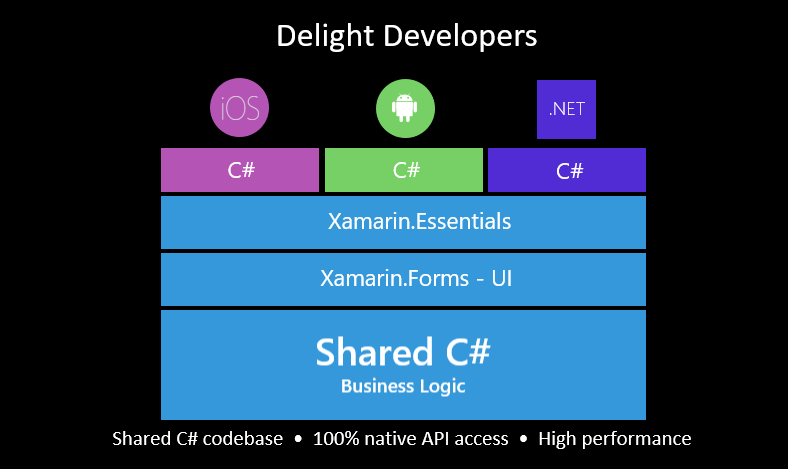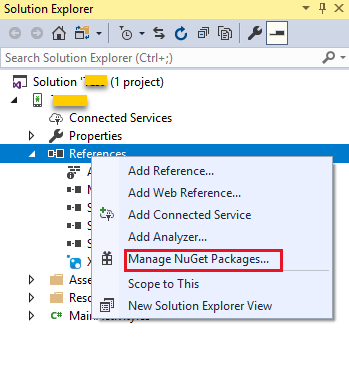

- XAMARIN VISUAL STUDIO TUTORIAL PDF HOW TO
- XAMARIN VISUAL STUDIO TUTORIAL PDF INSTALL
- XAMARIN VISUAL STUDIO TUTORIAL PDF CODE
XAMARIN VISUAL STUDIO TUTORIAL PDF HOW TO
This section demonstrates how to build a Xamarin.iOS application that uses PDFViewCtrl and your own version of libTools.a to build a PDF viewer.
XAMARIN VISUAL STUDIO TUTORIAL PDF CODE
However, if you wish to customize the behavior, you will need to do so using the included Objective-C source code and then prepare the. In the previous section you have seen how to use PDFViewCtrl with the tools add-on. Part 3: Create a new application with PDFNetiOS.dll and customized LibTools.a library. Var cache = Path.Combine (documents, ".", "Library", "Caches", "Cache2.pdf") Var documents = Environment.GetFolderPath () To set PDFViewCtrl associated with a PDFDoc from URL.PDFDoc docToOpen = new PDFDoc(“sample.pdf”) To set PDFViewCtrl associated with a PDFDoc from resources:.Then this document can be accessed directly by the file name, i.e.Make sure the Build Action of the document is set to BundleResource.Add the PDF document to the Resources folder (i.e.

To include a PDF document compiled with the project:.PDFViewCtrl mPdfViewCtrl = new PDFViewCtrl() To create a PDFViewCtrl control and set it as content view:.Initialize PDFNet with the following call before using any other PDFNet method:.You are now ready to use PDFNet and Tools libraries for your application!.
 Use LLVM optimizing compiler: under ‘iOS Build’ Advanced tab, check ‘Use LLVM optimizing compiler’:. Specify compiler information: in the application sample project, select ‘Options’, under ‘iOS Build’ > ‘Additional Options’ > ‘Additional mtouch arguments’, add ‘ –-compiler:clang++‘, and repeat this for all the build configurations:. Add reference to the Tools library: in Xamarin Studio, select ‘Edit References…’, browse to ‘/lib/ios folder, and add Tools.dll to the references. Add a reference to PDFNet: in Xamarin Studio, select ‘Edit References…’, browse to ‘/lib/ios folder, and add PDFNetiOS.dll to the references. Single View Application: In Xamarin Studio, from the ‘File’ menu select ‘New’ > ‘Solution’, choose ‘C#’ > ‘iOS’ > ‘Universal’ > ‘Single View Application’ template as shown below: Create a new Xamarin.iOS Application Project, i.e. ( If this is your first Xamarin.iOS project, it would be worth following Xamarin’s Xamarin.iOS Hello World project in this article before proceeding.) This part demonstrates how to create a brand new Xamarin.iOS application that uses PDFViewCtrl and Tools add-on to build a PDF viewer with a rich set of functionality. Part 2: Create a new application with PDFNetiOS.dll and Tools.dll. With tools functionality, long press on a blank field will bring up the tools popup menu:. The final application (running in iPhone simulator) will look like the following screenshot:. ToolManager toolManager = new ToolManager (mPdfViewCtrl) remove the following code from the ‘PDFNetiOSXamarinSampleViewController.cs’: Note that if you don’t need the tools functionalities, you can use only PDFNetiOS.dll library and not set tool for PDFViewCtrl, i.e. The project is now ready to run! Press ‘Run’ button to build the project and start the application. The project structure will resemble the following screenshot:. Open the sample project: In Xamarin Studio, from the ‘File’ menu select ‘Open…’ and browse to ‘/samples/PDFNetiOSXamarinSample’ folder shown below, select PDFNetiOSXamarinSample.sln and click ‘Open’. You will also need to install and setup Xamarin.iOS as described in this article. If you are using an out of date version of XCode you may encounter linker errors.
Use LLVM optimizing compiler: under ‘iOS Build’ Advanced tab, check ‘Use LLVM optimizing compiler’:. Specify compiler information: in the application sample project, select ‘Options’, under ‘iOS Build’ > ‘Additional Options’ > ‘Additional mtouch arguments’, add ‘ –-compiler:clang++‘, and repeat this for all the build configurations:. Add reference to the Tools library: in Xamarin Studio, select ‘Edit References…’, browse to ‘/lib/ios folder, and add Tools.dll to the references. Add a reference to PDFNet: in Xamarin Studio, select ‘Edit References…’, browse to ‘/lib/ios folder, and add PDFNetiOS.dll to the references. Single View Application: In Xamarin Studio, from the ‘File’ menu select ‘New’ > ‘Solution’, choose ‘C#’ > ‘iOS’ > ‘Universal’ > ‘Single View Application’ template as shown below: Create a new Xamarin.iOS Application Project, i.e. ( If this is your first Xamarin.iOS project, it would be worth following Xamarin’s Xamarin.iOS Hello World project in this article before proceeding.) This part demonstrates how to create a brand new Xamarin.iOS application that uses PDFViewCtrl and Tools add-on to build a PDF viewer with a rich set of functionality. Part 2: Create a new application with PDFNetiOS.dll and Tools.dll. With tools functionality, long press on a blank field will bring up the tools popup menu:. The final application (running in iPhone simulator) will look like the following screenshot:. ToolManager toolManager = new ToolManager (mPdfViewCtrl) remove the following code from the ‘PDFNetiOSXamarinSampleViewController.cs’: Note that if you don’t need the tools functionalities, you can use only PDFNetiOS.dll library and not set tool for PDFViewCtrl, i.e. The project is now ready to run! Press ‘Run’ button to build the project and start the application. The project structure will resemble the following screenshot:. Open the sample project: In Xamarin Studio, from the ‘File’ menu select ‘Open…’ and browse to ‘/samples/PDFNetiOSXamarinSample’ folder shown below, select PDFNetiOSXamarinSample.sln and click ‘Open’. You will also need to install and setup Xamarin.iOS as described in this article. If you are using an out of date version of XCode you may encounter linker errors. XAMARIN VISUAL STUDIO TUTORIAL PDF INSTALL
To complete this tutorial, you will need to install the latest version of XCode, which is required because its compilers are used by Xamarin.
Part 3: Create a new application with PDFNetiOS.dll and customized libTools.a library.  Part 2: Create a new application with PDFNetiOS.dll and Tools.dll. The completed sample project described in Part 1-3 is available by request from here. Note that the completed sample project described in Part 1 and Part 2 can be found in the samples folder located inside the PDFNet component package. You will also create an iOS Objective-C Bindings Library Project that allows you to customize our Tools library. In this tutorial, you will create a simple PDF viewing and annotating app. This tutorial shows the minimum steps needed to add a PDF viewing and annotating component to a Xamarin.iOS app using PDFNet SDK.
Part 2: Create a new application with PDFNetiOS.dll and Tools.dll. The completed sample project described in Part 1-3 is available by request from here. Note that the completed sample project described in Part 1 and Part 2 can be found in the samples folder located inside the PDFNet component package. You will also create an iOS Objective-C Bindings Library Project that allows you to customize our Tools library. In this tutorial, you will create a simple PDF viewing and annotating app. This tutorial shows the minimum steps needed to add a PDF viewing and annotating component to a Xamarin.iOS app using PDFNet SDK.








 0 kommentar(er)
0 kommentar(er)
